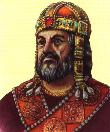
There is a Bulgarian proverb that says: if you want to know someone, give him power. The son of Tsar Peter I, Tsar Boris II proved to be a poor ruler. Under his watch, the Byzantines conquered Preslav and the whole of northeastern Bulgaria. After a short captivity in Constantinople Boris II was killed in an accident.
His younger brother Roman had been rendered impotent as a prisoner in Cosntantinople and in 978, though technically still tsar, he voluntarily surrendered the power to his military commander Samuil. Though not a member of a royal family, Samuil proved born to rule. He came from the free southwestern lands (Macedonia). His father Nikola was head of the Sredets komitat (administrative region]. During the tumultuous reigns of Peter and Boris, when invaders were harassing the Bulgarian outlands, Nikola's four sons zealously fought for Bulgaria's independence. After ten years of ceaseless battles they succeeded in liberating the northeastern territories. However, soon afterwards the sons Moses and David were killed in the battles with the Byzantines. The third son, Aaron, was accused of treason and was killed together with his family on Samuil's order. Only Aaron's son, Ivan Vladislav, was spared owing to the fervent pleads of Samuil's son Gavril Radomir.
Samuil continued to repulse Byzantine attacks. He persevered for almost four decades, though the Byzantine empire was at the height of its power. In the battle for the survival of his people and his state, Samuil gained the reputation of an able commander and politician and earned the love of his subjects. He was a restless, militant man, reads his description in a Byzantine chronicle. Indeed, for many years the Bulgarians took fortress after fortress in Thrace and around Adrianople. Much of the empire's western territories came under Bulgarian control. Samuil's horsemen went south all the way to Peloponnese and Corynth, and they unfurled his flag in Larissa, a key fortress for the control over Thessaly.
The Bulgarians were again victorious in the battle at Troyanovi Vrata. On 17 August 986 Emperor Basil II fled, leaving behind his treasure hoard and a supply train. Byzantine chronist John Geometres lamented over the defeat: "May those ominous trees and mountains vanish from the face of earth! The Istrum (Bulgaria] grabbed the crown from Rome (Byzantium]. The Moesian (Bulgarian] arrows proved stronger than Byzantine spears...
Elated by their victory, the Bulgarians won a series of battles. Strongholds like Vereia and Servia in southern Macedonia fell to their assaults. Samuil reached the Aegean coast when his troops overran the region of Drach. A successful campaign against the Serbs forced their prince to accept the patronage of the Bulgarian tsar That campaign marked the end of a tumultuous decade in Bulgaro-Byzantine relations. Under Samuil, Bulgaria was again established as a great power in the Balkans. "Samuil waged prolonged wars with the Greeks and drove them out of Bulgaria, so that in his time they did not even dare set foot on Bulgarian soil," a Byzantine chronicler wrote.
However, when Basil II recovered from the defeat at Trayanovi Vrata, he set out to put the internal affairs of the empire in order. In a new drive against Bulgaria, Tsar Roman was again taken captive and later died in prison in Constantinople. He was the last of Simeon's dynasty. In 997 Samuil had himself crowned as Tsar. His title was recognized by the Holy See. A brief suspension of hostilities with Byzantium allowed him to turn his efforts to the internal concerns of his state, which some historians call Western Bulgaria.
Samuil's state spread from the northeastern most Bulgarian territories to Southern Macedonia. The boyars and their fortified towns submitted to Samuil's supreme authority. The nobles actively supported their tsar in the fights with Byzantium, for they knew the advantages of unity. Samuil moved his capital from Sredets (Sofia) to Voden, to Prespa and finally to Ohrid, in reaction to the developments in the war with Byzantium.
In the newly erected palace in his last capital, Ohrid, Samuil developed and enforced the state system devised in Simeon's times. The Kav-Khan remained the highest dignitary, the tsar's right-hand man. The Church was headed by a patriarch. In the heart of the state - the lands around Sofia and in Macedonia - fortified castles were erected to repel Byzantine attacks. Numerous churches, stone carvings and paintings in Ohrid, Prespa and Kostur testify to the tsar's concern about the spiritual aspect of Bulgarian life.
Meanwhile, Emperor Basil II once again raised an army and started a new campaign against Bulgaria in 1 001. Samuil fought fiercely but was forced to retreat and give away lands. Many of his nobles, like Krakra of Pernik, heroically defended their strongholds. Others chose to become traitors in order to survive. Disunity gradually depleted Samuil's state.
The fatal moment came in the summer of 1014 when the Bulgarian army suffered a crushing defeat in a gorge of the Strumitsa river near the village of Klyuch in Macedonia. Upon victory, Emperor Basil IT ordered the 14,000 Bulgarian prisoners blinded. One in every hundred men was left with one eye in order to lead the men home.
At the sight of the blinded soldiers Samuil suffered a heart attack and died. His son, Gavril Radomir, spent only a year on the throne before being killed by Ivan Vladislav, the man whose life he had once saved. When tsar Ivan Vladislav was killed in a battle in 1018, nothing could stop the emperor from taking Ohrid. His cruelty won him the name of Bulgaroctonus: Slayer of the Bulgars; Bulgaria fell under Byzantine domination.

 My name is Radostina Georgieva, "Roddy".
My name is Radostina Georgieva, "Roddy".